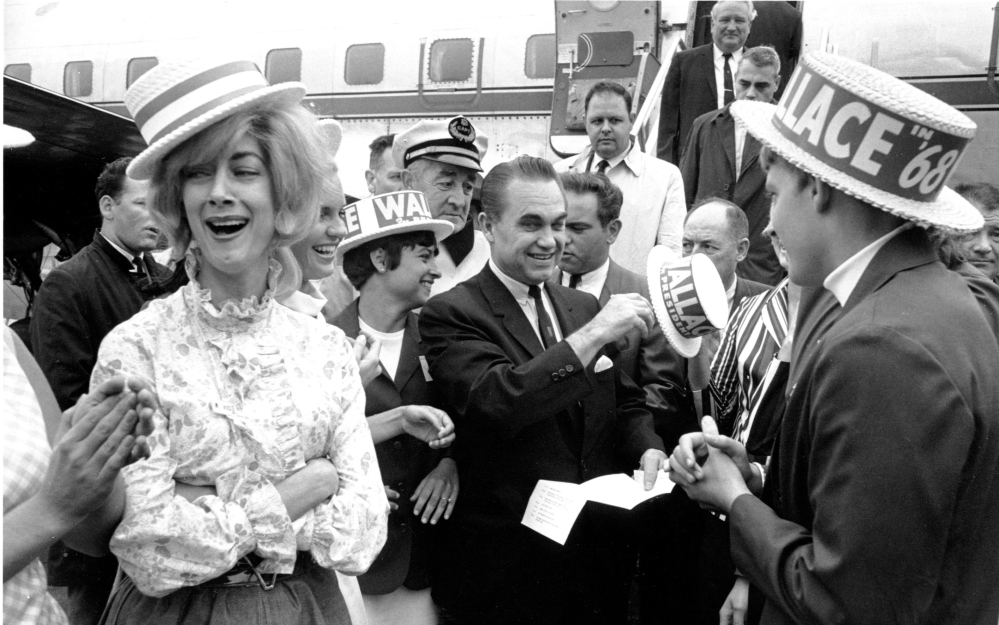ATLANTA — Almost five decades before Donald Trump’s campaign events turned violent, fists and folding chairs flew at rallies for another U.S. presidential candidate riding a wave of populist rage and dismissed by party elders and pundits.
Peggy Wallace Kennedy, 66, remembers being hustled offstage as her father, the late George Wallace, campaigned in 1968 to erupting crowds: “It was very scary. My father’s rallies, they could be right rough.”
A four-term Alabama governor who had championed segregation, Wallace ran for president four times between 1964 and 1976, whipping up followers with a message of class resentment. He taunted protesters and opponents he labeled anarchists, long-haired hippies and pointy-headed professors too stupid to park their own bicycles.
To those at his side then, the current Republican front-runner’s winning streak, propelled by the conviction that a Washington elite has sold out the country, has a quality of deja vu.
Trump is hitting “on the same things we were hitting,” said Charlie Snider, 84, who managed two of Wallace’s campaigns. Snider speaks with respect – he is supporting Trump.
Wallace began his gubernatorial campaign in 1958 as a moderate segregationist, and was beaten by a more extreme one backed by the Ku Klux Klan. His next time out, he made sure that wouldn’t happen. “Segregation now, segregation tomorrow, segregation forever,” he said in 1963 in his inaugural address.
Trump is no segregationist but, like Wallace, has built his campaign on the anger of the disaffected. In Wallace’s time, that was largely about a loss of white privilege. Today, Trump has focused on faltering economic opportunities, undocumented immigrants and international trade deals.
Wallace first ran for president as a Democrat in 1964. When he ran as an independent in 1968, he won five Southern states, campaigning on a “law-and-order” platform. In 1972 he tried again as a Democrat, campaigning against busing for school integration. That was the year he seemed most Trump-like, drawing surprisingly large crowds, high poll numbers and unexpected victories as he assailed the elite to the dismay of the Democratic establishment. It was a time reminiscent of today with an inchoate national malaise and rapidly shifting social mores.
In a crowded primary field, Wallace won 42 percent of the vote in Florida, taking every county and stunning the press, according to Snider. “I told them that night, ‘You all have been talking to the wrong people. You need to talk to the cab drivers and bus drivers and small businesses.’ ”
That is what Trump backers have been telling the Republican leadership: It is out of touch with the ordinary people who back him.
Wallace was shot two months later in Maryland. He ran once more in 1976. Snider persuaded him to drop out, saying voters weren’t going to accept him in a wheelchair. Wallace died in 1998, having apologized for his support for segregation and begging forgiveness.
Trump and Wallace draw similar voters but came from very different places.
The billionaire Trump, a graduate of the Wharton School of Economics, was to-the-manor born, inheriting and expanding his father’s New York City real-estate empire. He called for the return of the death penalty for the so-called Central Park Five, a group of black teenagers accused of rape and later exonerated. He entered the presidential race well known as a name atop luxury properties worldwide and a reality TV star, but a novice at politics.
Wallace was the son of a farmer and entered public life at a young age. An amateur boxer, he got his law degree at the University of Alabama, got elected to the state legislature and became a jurist, known as the “fighting little judge,” before mounting his first campaign for governor in an Alabama whose politics were defined by racial segregation.
Send questions/comments to the editors.



